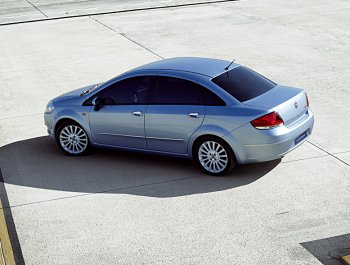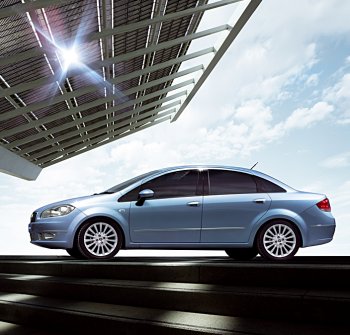|
SAFETY
|
|
Active safety
The Fiat Linea is fitted with the most sophisticated
electronic systems to monitor the car’s dynamic behaviour,
which intervene to raise the dynamic limits even higher and
to enhance safety, without being intrusive for the driver.
These devices were developed by simulation and painstaking
road tests to ensure that they do not detract from the
pleasure of driving. The wide range of equipment is
described below.
ABS complete with EBD
(Electronic Brake force Distribution)
In addition to its excellent braking system, the Fiat Linea
is also equipped with one of the most advanced ABS anti-lock
braking systems on the market, complete with EBD electronic
brake force distribution. The latter distributes the braking
force over the four wheels to prevent them from locking,
guaranteeing complete control of the car in all conditions.
The system also adapts to the grip conditions of the wheels
and the efficiency of the brake pads, preventing the latter
from overheating.
ESP (Electronic Stability
Program)
The sophisticated ESP system cuts in when conditions are
close to the limit, when the car’s stability is at risk, to
help the driver to control the vehicle. To do so, ESP
constantly verifies how the tyres grip the ground,
longitudinally and laterally, and if the car does skid, it
intervenes to recover the trajectory and the stability of
the trim. It incorporates sensors that measure the vehicle’s
rotation around its vertical axis (yaw speed), the lateral
acceleration and the steering angle set by the driver (which
indicates his chosen direction). It then compares these data
with the parameters processed by a computer and uses a
complex mathematical model to establish whether the car is
taking a bend within the grip limits, or whether the front
or rear is about to veer (understeer or oversteer). To bring
it back to the correct trajectory, the system generates a
yaw moment opposite to the one that caused the instability,
singly braking the appropriate wheel (nearside or offside),
and reducing engine power by adjusting the throttle valve.
This is where the device developed for the Fiat Linea
differs from other systems. Its action on the brakes is
modulated to be as gentle as possible (therefore without
disturbing the driving), and the reduction in engine power
is limited, to guarantee excellent performance and enjoyable
driving at all times. ESP is always engaged.
ASR (Anti Slip Regulation)
ASR (Anti Slip Regulation), which optimises traction at all
speeds, using the brakes and engine management, is an
integral part of the ESP system. Based on the number of
wheel revs calculated by the ABS sensors, the device
calculates the degree of slipping and activates two
different control systems to recover grip. When an excessive
demand for power causes both drive wheels to slip (for
example when aquaplaning or accelerating on an uneven,
snow-covered or icy road surface), the system reduces engine
torque by decreasing the throttle valve aperture and thus
the air flow. If only one wheel slips (for example the wheel
inside a bend following acceleration or dynamic changes to
the load), this is automatically braked without the driver
having to press the brake pedal. This obtains an effect
similar to that of a self-locking differential, enabling the
Fiat Linea to tackle road surfaces with poor grip without
any difficulty. ASR is engaged automatically every time the
engine is started, but can be excluded by a switch on the
centre console. It is only necessary to de-activate ASR when
mounting snow chains, because in order to transmit torque to
the ground, the wheel has to be able to “pile up” snow with
small slips that the ASR system tends to avoid.
Hill Holder - HBA
The Hill Holder, which is an integral part of the ESP
system, helps the driver during hill starts. It cuts in when
the ESP control unit perceives a difference in the
inclination of the car through a longitudinal acceleration
sensor on the floor under the front passenger seat. During a
hill start, the control unit prepares to act when first gear
is engaged and the brake and clutch pedals are depressed.
The pressure on the front brake callipers is maintained for
about 1.5 seconds after the driver removes his foot from the
brake pedal, allowing him to set off without difficulty. The
Hill Holder is not activated when the car is started
downhill with first gear engaged. The same occurs when
reverse is engaged: the system is activated for downhill
starts, and it is not activated for uphill starts. And
finally, there is the option of HBA, electro-hydraulic brake
assistance, which automatically increases the pressure on
the braking circuit during panic braking.
MSR (Motor Schleppmoment
Regelung)
This device, also an integral part of the ASR system, acts
when there is a sudden change of gear when changing down, to
return torque to the engine and prevent excessive dragging
of the drive wheels, which could cause the car to lose
stability when grip is poor.
|
 |
|
 |
|
Passive safety
The Fiat Linea is one of the safest cars in its segment.
Total protection, which starts with the devices that are
dedicated specifically to safety: as many as 6 airbags, two
of which are of the multistage type, three-point seat-belts
with pre-tensioners and load limiters, five head-restraints
and the FPS fire prevention device. Then the new chassis,
which was designed to absorb any impact very effectively.
And finally, the contribution made to occupant protection by
the bodywork, the bonnet, doors and facia crossbeam. Nor can
we overlook the contribution made to passive safety by other
elements such as the seats or the steering column, which
were designed taking their behaviour in an accident into
consideration.
The Air-Bag Smart 2 system
Complete protection, intelligent protection. In a head-on
impact, occupants are protected by an innovative restraint
system known as ‘Air-Bag Smart 2’, because it automatically
adapts the activation parameters according to the severity
of the accident. Starting from two front airbags for the
driver and passenger, which adopt a different logic from
conventional airbags. Until now, when the airbags were
activated, they inflated simultaneously up to their maximum
limit, which was established to safeguard occupants during
severe impacts. The Fiat Linea, on the other hand, adopts
front airbags with dual-stage activation; this means that
the system only activates the first of the two stages when
the impact is of moderate strength, but activates both in
the event of a more serious collision. The two stages can
also be activated with different sequences depending on the
type of impact. In any case, the bridles inside the bags
guarantee that the maximum dimensions and the shape taken by
the cushions are as non-invasive as possible for passengers.
The front passenger airbag can obviously be de-activated
(using the menu on the control panel), so that a child can
be carried in a safety seat facing backwards on the front
seat (the pre-tensioner on the other hand remains active).
The sensors of the ‘Air-Bag Smart 2’ system also control the
activation of the seat-belt pre-tensioners. The Fiat Linea
is fitted with front seat-belts that are each complete with
an inertia reel, pre-tensioner and load limiter. On impact,
the electronically controlled pyrotechnic pre-tensioner
retracts the belt in a few milliseconds, so that it adheres
perfectly to the body. The load limiters are positioned
inside the inertia reels, and they yield in a controlled
manner, metering the force exercised by the belt on the
shoulder of the person wearing it.
Curtain-bags and sidebags
The optional curtain-bags are airbags that descend along the
windows to protect occupants’ heads in the event of a
side-on collision. The curtain-bags adopted on the Fiat
Linea are more protective than other systems (because they
always take up the correct position), faster to inflate and
less invasive for passengers. They open from the top down
and there is no risk of their causing secondary injury to
the occupants’ arms with their movement. They also
effectively protect the heads of both front and rear
passengers, because they extend the whole length of the side
windows, protecting occupants even if the car overturns. The
two bags (one on each side) are positioned under the
longitudinals of the roof, folded inside a closed
compartment. At the appropriate moment, the cover bends to
allow the bags to inflate and to descend. And finally, to
protect the pelvis and chest of passengers even if they hit
the sides of the car, the Fiat Linea also fits sidebags
inside the seat squabs, where they protect the occupants
best, regardless of the latter’s stature or position, or the
seat regulation.
Stringent tests for total
protection
The new car was subjected to possible types of high speed
collisions in order to verify on the spot the effectiveness
of the integrated protection system developed. The results
were then analysed on the basis of the structural and
biomechanical parameters envisaged by some of the world’s
most stringent legislation. The styling of the front part of
the Fiat Linea was developed bearing the protection of
pedestrians in mind. The volumes are smooth and rounded, and
there are no sharp edges that could injure pedestrians. The
large surface of the bonnet minimises the risk that a
pedestrian’s head could hit the front uprights.
The sturdiest components in the engine bay are positioned at
a suitable distance from the bonnet, to allow the ‘skin’ of
the bonnet to absorb the energy deriving from impact with a
pedestrian’s head better. The new model also features all
the devices that guarantee absolute safety for children
travelling in the car. The most important, and most
effective, of these are the Isofix attachments on the rear
seats, and the de-activation of the front passenger airbag
by the onboard computer. |
|